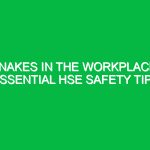Fork truck Safety is a critical component of maintaining a safe working Environment, particularly in industries where heavy machinery is frequently used. In the Health, Safety, and Environment (HSE) domain, understanding and implementing effective fork truck Safety practices can significantly reduce the risk of accidents, injuries, and fatalities. This article will explore essential fork truck safety tips, providing insights into Best Practices, regulations, and real-life examples to create a safer workplace.
Understanding Fork Truck Safety
Fork trucks, commonly referred to as forklifts, are essential tools in warehouses, construction sites, and manufacturing plants. They are designed to lift and transport heavy loads, making them invaluable for improving efficiency. However, the misuse or lack of proper Safety Measures while operating fork trucks can lead to severe accidents. Fork truck safety encompasses a range of practices, protocols, and Regulations aimed at minimizing the risk associated with using these machines.
In the HSE context, fork truck safety is not just about the operators; it involves everyone in the workplace. From ground staff to management, understanding the risks and implementing Safety Measures are crucial for fostering an environment where safety is prioritized.
Key Components of Fork Truck Safety
1. Operator Training and Certification
One of the most vital aspects of fork truck safety is ensuring that operators are adequately trained and certified. Training programs should cover the following:
- Understanding the controls and functions of the fork truck.
- Load handling techniques to prevent tipping or dropping.
- Awareness of the surroundings to avoid collisions.
- Emergency Procedures in case of incidents.
Real-life anecdote: A warehouse manager recounted a near-miss incident where an untrained employee attempted to operate a fork truck, resulting in a close call with a pedestrian. This incident highlighted the importance of proper training and the potential consequences of neglecting this critical safety measure.
2. Conducting Regular Safety Inspections
Regular inspections of fork trucks are essential for identifying potential Hazards before they lead to accidents. Operators should perform daily checks that include:
- Inspecting brakes, steering, and controls for functionality.
- Checking the condition of forks and attachments.
- Ensuring that safety devices, such as horns and lights, are operational.
By addressing issues promptly, companies can prevent accidents caused by mechanical failures. A case study from a logistics company showed that implementing a rigorous inspection schedule reduced accidents by 30% over a year.
3. Proper Load Management
Managing loads correctly is crucial for safe fork truck Operation. Operators should adhere to the following guidelines:
- Always know the weight of the load and ensure it is within the fork truck’s capacity.
- Center the load on the forks to maintain balance.
- Use appropriate attachments for specific loads, such as clamps or extensions.
Failure to adhere to these practices can lead to tipping, collisions, and injuries. For instance, a construction site reported an incident where improper load distribution caused a fork truck to overturn, injuring the operator and damaging nearby equipment.
4. Maintaining Clear Communication
Clear communication among team members is vital when operating fork trucks. Establishing protocols for signaling and communication can prevent accidents. Best practices include:
- Using hand signals or radios to communicate when moving loads.
- Implementing a system to alert pedestrians when a fork truck is in operation.
- Designating specific walkways for pedestrians to minimize interaction with machinery.
In one incident, a worker was injured when a fork truck approached without warning. This incident underscored the importance of communication and the need for designated signaling protocols.
5. Implementing Safety Zones
Creating safety zones within the workplace can significantly enhance fork truck safety. This involves:
- Establishing marked pathways for fork trucks to navigate safely.
- Designating pedestrian areas that are separate from high-traffic machinery routes.
- Using clear signage to indicate where fork trucks operate and where pedestrians should not enter.
A manufacturing plant that implemented designated safety zones reported a 40% decrease in near-miss incidents, demonstrating the effectiveness of this strategy in promoting safety.
Identifying Hazards and Risks
Understanding potential hazards associated with fork truck operation is crucial for preventing accidents. Common risks include:
- Collisions with pedestrians or other vehicles.
- Overturning due to improper load management.
- Falling loads caused by inadequate securing techniques.
- Inadequate visibility leading to accidents in blind spots.
By identifying these risks, organizations can implement targeted strategies to mitigate them. For example, a company that installed cameras on fork trucks to improve visibility in blind spots found a significant reduction in collisions.
Legal Regulations and Standards
Numerous regulations govern fork truck safety, ensuring that organizations adhere to minimum safety standards. Some key regulations include:
- The Occupational Safety and Health Administration (OSHA) guidelines, which outline safe operation practices and training requirements.
- The Health and Safety at Work Act, which mandates employers to ensure the safety of their employees.
- Local regulations that may impose additional requirements based on industry-specific risks.
Compliance with these regulations is not just a legal obligation but a moral one to protect employees and minimize workplace hazards. For instance, organizations that neglect osha training requirements may face significant fines and increased risk of accidents.
Best Practices for Fork Truck Safety
1. Regular Training and Refresher Courses
Fork truck operators should participate in ongoing training programs to stay updated on safety practices and regulations. Refresher courses can help reinforce knowledge and address new safety protocols as they are developed.
2. Encouraging a Safety-First Culture
Organizations must promote a culture that prioritizes safety at every level. This can be achieved by:
- Encouraging open communication about safety concerns.
- Recognizing and rewarding Safe Practices among employees.
- Providing resources and support for safety initiatives.
A company that fostered a safety-first culture through regular meetings and incentives saw a marked improvement in safety compliance and employee morale.
3. Utilizing Technology for Safety Enhancements
Incorporating technology can greatly enhance fork truck safety. Examples include:
- Telematics systems to monitor fork truck performance and operator behavior.
- Collision avoidance systems that alert operators of nearby pedestrians or obstacles.
- Wearable technology that tracks operators’ fatigue levels and alerts them when they need to take breaks.
By leveraging technology, businesses can proactively manage safety risks and improve overall operational efficiency.
Conclusion
Fork truck safety is an integral part of maintaining a safe workplace. By focusing on operator training, regular inspections, effective communication, and adherence to regulations, organizations can significantly reduce the risk of accidents. The importance of fostering a culture of safety cannot be overstated; it requires commitment from all levels of the organization. Through the implementation of Best Practices and the use of technology, we can create a safer workplace that prioritizes the health and well-being of all employees.
As we continue to navigate the complexities of Workplace Safety, let us remember that every effort counts. By prioritizing fork truck safety, we not only comply with legal standards but also take a significant step toward safeguarding lives and promoting a healthier work environment.


